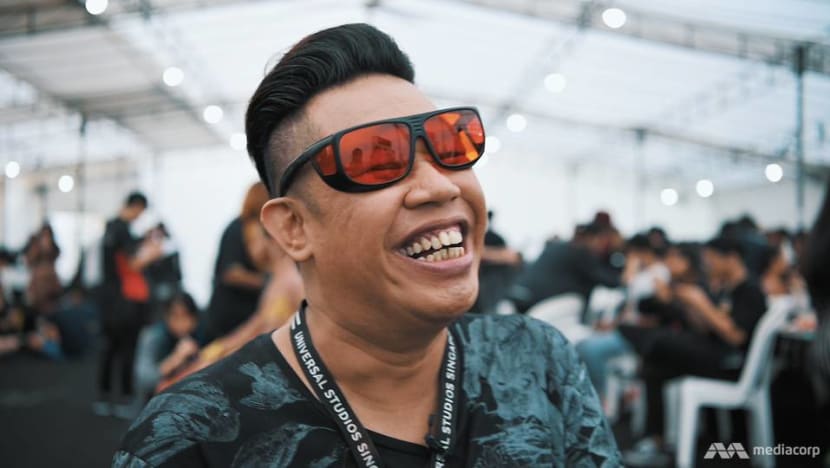Breaking free from his shades of grey: The visually impaired make-up artist
Iskandar Ibrahim’s cosmetics career was cut short when he could no longer tell shades of colours apart. But even as his vision deteriorated, his skill did not — and he can now see that.

He lost the ability to see in bright light. But his make-up dreams are undimmed.
SINGAPORE: Five times out of six when Iskandar Ibrahim applied for a job in the cosmetics line, he was accepted. After all, he was an award-winning make-up artist who had a decade of experience at MAC.
But when he had to sign the contract or start work, he always hesitated. In his heart, he knew he was more than qualified — but each time, he questioned his ability, and whether his potential employers would really accept him.
In 2014, he was diagnosed with photoreceptor dysfunction, an eye condition in which the cells in the retinas degenerate prematurely. It means he cannot see in bright light, nor tell shades of colours apart.
“I was afraid that they’d reject me because of my condition,” says the 44-year-old. “Perhaps it was a pride issue … But I felt like I was lying to myself and lying to them.
“So every time it was time to sign the contract, I couldn’t.”

It has been five years full of longing, loss and trying to find his way back to his first love.
Iskandar, who prefers to be known as Shawn, still sees in shades of grey. But the excuses have stopped, and he is now giving himself a chance to bring colour to others as a make-up artist once again.
HIS DREAM JOB
Before things went downhill for Shawn, he was living the dream with MAC, feeling as if he had it all: Glamorous fashion shows with top local designers, overseas trips with his team for conferences, and most of all, the prestige.
“When you’re at MAC, you’re something,” he says. “Everybody knows.”
It was hard work, but he enjoyed it. Beyond the glamour, he loved the brand and what it represented: Creative, flamboyant and colourful — the same qualities he would ascribe to himself, and was known to be.
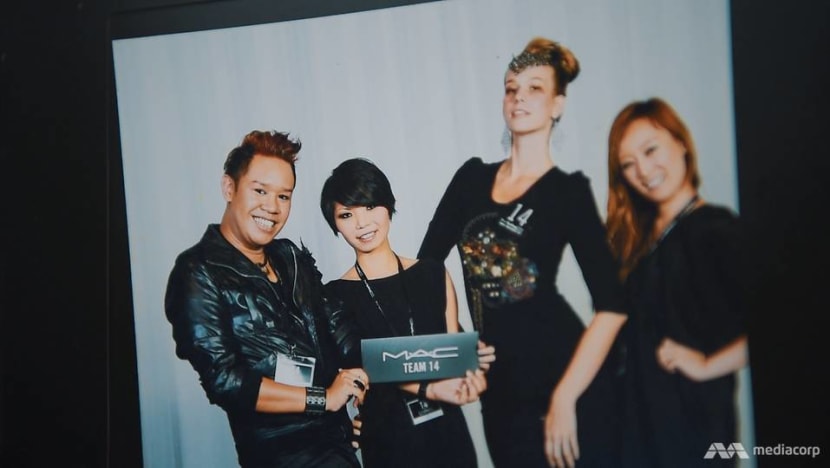
“When I went to work, I dressed so stylishly, with boots and all,” recalls Shawn, who had been posted to the duty-free hall at Changi Airport. “And when everybody saw me, it was like, ‘Wah, celebrity come already!’”
Dressing to the nines every day meant polishing his boots, ironing his T-shirts and, of course, wearing make-up.
He favoured bold, dramatic lines: Thick, winged liner and sparkly eye shadow, with a deep red lip colour — Ruby Woo or Russian Red.
It was, he says with a smile, a hallmark of his style, which he had developed in his early 20s from making and dressing up in costumes and wigs to perform in drag at clubs.

He was known then as Shawn Flower. But to his friends, it was clear that drag was simply his hobby. His real love was MAC.
“He shines at drag, but I think when he got his job as a make-up artist … you could see that it was different for him,” says Aidil Abdullah, who has been his friend for more than 20 years.
“You could see how confident, how radiant he was, and he knew what he was talking about … He was in his prime when he was in MAC.”
THE MISTAKES BEGAN
But one day in 2012, he realised his eyesight was not what it used to be. There was a slight fuzziness, and at times, he saw black dots dancing in front of his eyes.
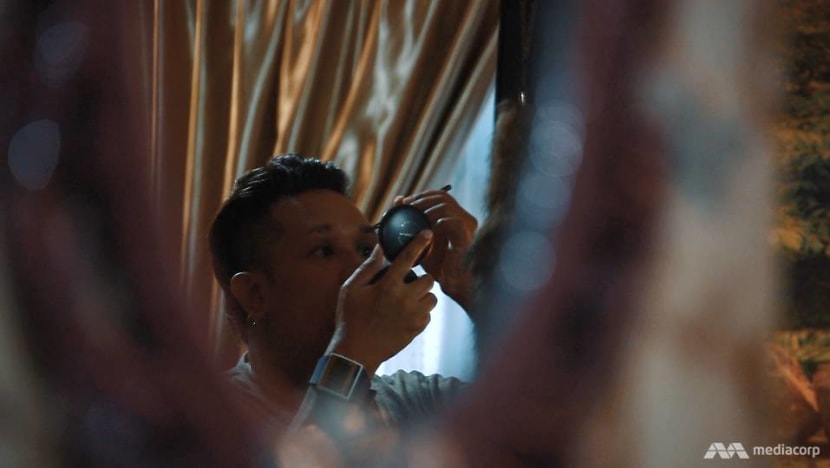
It seemed worse in places with bright lighting, such as the harsh sunlight of the early afternoon or on the shop floor of the cosmetics counter.
Then there were the waves of giddiness and the migraines, which sometimes caused his eyes to water from the pain.
He realised he was having problems reading the codes on the products that came in. He started making mistakes: Stocks of make-up ended up in the wrong place, and he started giving customers the wrong products.
He began using a magnifying glass discreetly to read product codes. He began directing customers who had come for makeovers to sit in a chair with dim lighting, so he could do their make-up without straining his eyes.
But the mistakes kept happening. And customers started to complain. “My colleagues started asking me … Shawn, what happened to you?’” he recounts. “Normally, you don’t make any mistakes.
“They asked me: ‘Are you okay? Is there something wrong with your eyes?’”

But he kept quiet.
“I didn’t want to tell people because I didn’t want people to look at me as if I wasn’t normal,” he explains. “So I just tahan.”
Until he could no longer hide it. Growing increasingly concerned about his performance, Shawn’s managers urged him to see an eye specialist. And in early 2014, he was diagnosed with the condition.
In bright light, what he sees is a sea of white and vague black or grey shapes. In dim lighting, things are still a bit blurry. While he can see primary colours such as red or yellow, he cannot make out the different shades.
Working at MAC was his dream, but he was torn. With the mistakes mounting and his vision deteriorating, he was no longer sure he could do it.
So he left.
WATCH: The visually impaired makeup artist (4:45)
HIS LOWEST POINT
In his darkest days, there were times when Shawn admitted to himself that he had perhaps never wanted to acknowledge his condition. “Sometimes I just blamed myself,” he says.
He made excuses to avoid meeting his friends. Only one or two close pals knew about his situation.
For six months after he left his job, all he did was sit at home and cry. Paralysed with grief, he could not bring himself to apply for another job. It was the lowest point in his life.
When he did have to go out, there were times midway through a journey when he came to a standstill and cried because could not see where he was going.

He was referred to the Singapore Association of the Visually Handicapped (SAVH), which gave him special red-lensed glasses to reduce the glare of bright light so he could go out in the daytime.
Even so, he estimates his visual improvement at 50 to 60 per cent at most.
Things got worse for him when his ailing mother died in 2017 from pneumonia. He had always been close to her and had been planning to buy a new flat where she could live.
The day she was buried was the first time Shawn’s close friend Abdul Malik realised the depth of his problem.
“We had to walk to the cemetery, and he couldn’t even move … He had to hug me to go through the graveyard,” he recalls. “I carried an umbrella to shade him, and he was wearing his sunglasses. But he couldn’t see.”
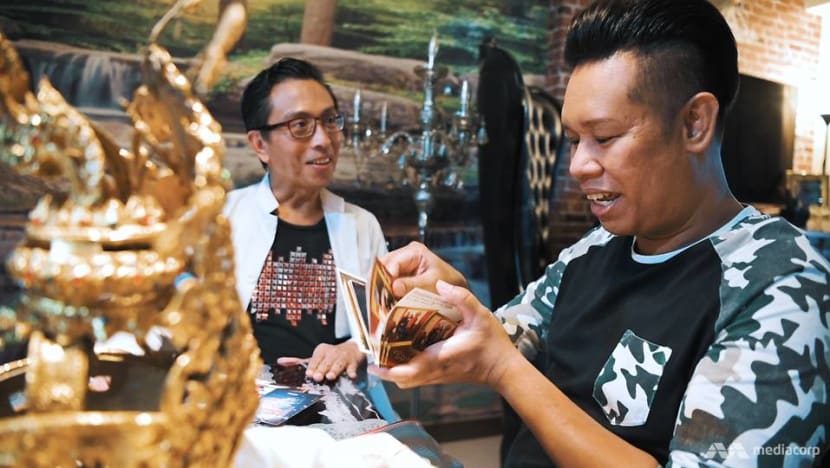
He pauses to offer a tissue to Shawn, whose tears are flowing down at the memory.
“He couldn’t see his mother’s face for the very last time.”
THE TURNING POINT
For a time, Shawn lived off his savings. As his bank balance dwindled, his desperation grew. But he ended up in a quandary over his job applications.
At the end of last year, he received a phone call from his social worker at the SAVH. A fragrance company named Firmenich was looking to hire sensory panellists, who would smell and profile the fragrances the company produced.
Though it was only part-time, the job gave him a steady income. It was also a turning point for him.
READ: He lost his sight at 47 - a fragrance company helped give him his life back
As he worked with others who were visually impaired, he realised that there were opportunities for people like him. “My friends who were totally blind could do so many other jobs,” he says. “So why not me?
“They always told me … Shawn, if you get any job, just go for it,” he adds. “If we can do it … you can as well.”

Seeing the way his Firmenich trainers, Siau Choon and Thibault, adapted the work practices to accommodate the panellists’ disabilities also made him more accepting of his condition.
He promised himself that should he apply for other jobs in future, he would declare his condition up front. “Whether I get (the job) or not, that’s another story,” he says.
ALLOWED TO BE HIMSELF
Another job that helped him regain his confidence, he says, is one that has allowed him to be himself, dress up flamboyantly again and, best of all, work at night — away from the glare of the daytime light.
This is now the sixth year he has participated in Universal Studios Singapore’s annual Halloween Horror Nights, first as a make-up artist and then as a part-time scare actor.
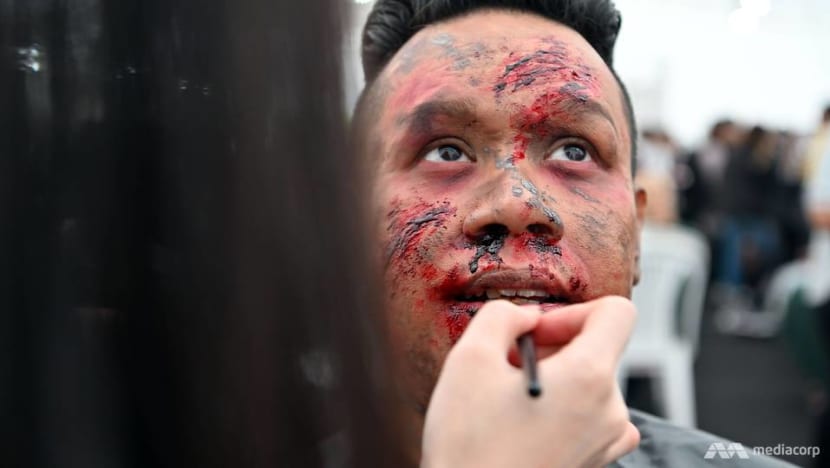
“Whatever character they give me, I try my best to become that character,” he says. “This has made me want to try more things and do more things that I’ve never done before.”
In this year’s edition, he plays a victim in a Japanese-themed haunted house filled with eerie dolls. Dressed in a checked shirt and with fake blood and gore running down the side of his face, he certainly looked the part.
“Help me!” he yells as people are ushered through a darkened passageway. “Yumi’s coming!”
From his animated chats with the make-up artist in the holding area, to the gleam in his eye when he stretches out his hand towards a screaming visitor, it is clear that he enjoys every bit of the acting.
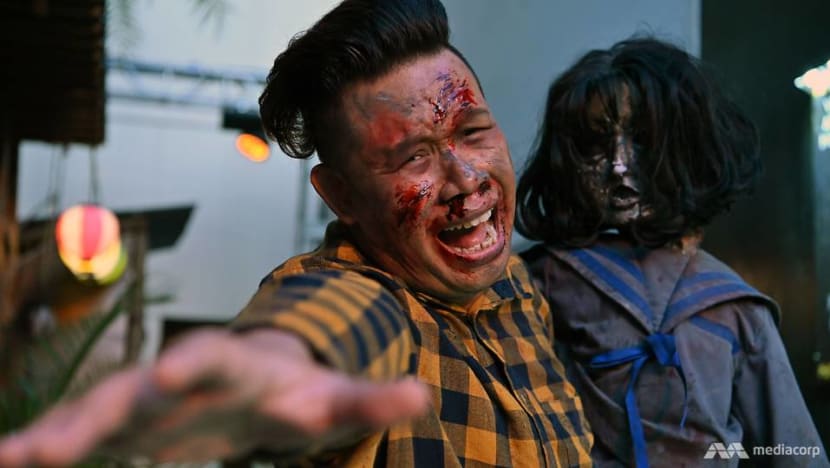
“Today,” he says, making a dramatic gesture with his hands and flourishing his puppet Yumi, “I’m Mariah Scary!”
Halloween Horror Nights has been an escape for him, says Aidil. “He always seems extra cheerful when he’s doing it.”
But the issue is that there is a limited run every year. Shawn has been approached to work at the theme park for its Christmas events, but as these were in the daytime, he had to decline.
“I always ask them … do you have any night one?” he says. “If there is, I want to join.”
When he puts on his costume, his demeanour changes. It offers a glimpse of what he could have been like years ago as a flamboyant performer in a blonde wig and a glittery dress.
PINING FOR HIS FIRST LOVE
Today, the remnants of Shawn’s drag days are packed away in boxes in his wardrobe. There is a leopard-print tunic with butterfly sleeves; a rainbow scarf; and a brown wig that he quips makes him look like supermodel Tyra Banks.

But he has long since closed the door on that part of his life. In his bedroom, his make-up collection takes pride of place. In a clear drawer under his mirror, there are eye shadows in every colour of the rainbow.
As he slings his make-up belt over one shoulder, he has the look of a dedicated professional, ready to showcase his skills on a model.
As far as he is concerned, he remains a professional. Despite his sight, he is able to do make-up in dim lighting. Besides the various part-time jobs he juggles, he also takes on freelance make-up assignments.
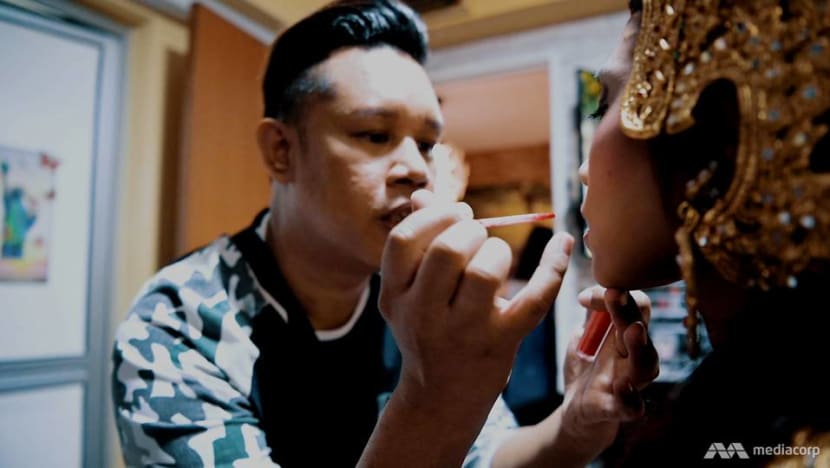
Although he uses a magnifying glass to read the product codes, it is sometimes unnecessary; he knows MAC products so well that he is able to tell — from memory — what the colours look like and how the products behave.
“Sometimes I can’t see,” he says as he sweeps a shimmery mineral eye shadow onto his friend’s eyelids. “But I know that mineral products always fall off because of the pigment, so I’ll take a brush and sweep it off.”
He makes minor adaptations to accommodate his condition, he says. Sometimes he gets his customer to help him read product codes or identify products. He also places a mirror in front of his customer and would ask from time to time if what he is doing works.
It does for the most part.
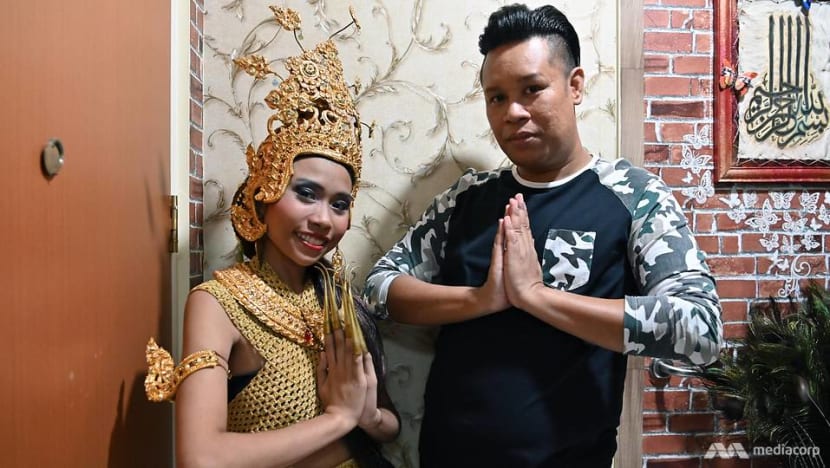
Today, not only has he accepted his condition as a part of him and regained some confidence, he also accepts that the experience of losing part of his vision has made him a better person — humbler and nice to everybody.
“Before, I was very proud,” he admits. “I’d always thought of myself as a make-up artist … so glamourous. But … everything changed.”
In his heart, however, he longs to return to his first love, MAC. With the bright lights, he knows it would be a challenge. But perhaps, he thinks aloud, he could work in a dimmer environment?
“If there’s a chance for me to come back, I’d come back without hesitation,” he says. “Part-time also (I don’t) mind … I just want to be with the team.”
He feels wistful about what he has lost. But as he sweeps a bright pink blusher on his model and selects a bronze lipstick for her, it is clear that he can still add colour to people’s lives, as he did at the height of his career.
